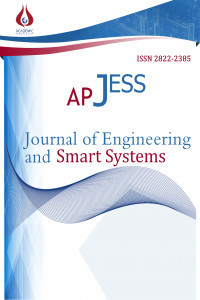Elektrolitik Sert Metal Kaplamaya Alternatif Çevreye Duyarlı Ni-P Kaplamaların 6061 Serisi Alüminyum Altlık Üzerine Akımsız Yöntemle Biriktirilmesinde Sodyum hipofosfit, Sıcaklık ve Zamanın Etkisi
Akımsız nikel kaplama, sodyum hipofosfit, sıcaklık, zaman
The Effect of Sodium Hypophosphite, Temperature and Time in co-deposit Ni-P Coatings on 6061 Series Aluminum Substrate: An Environment-Friendly Alternative to Electrolytic Hard Metal Coatings
Electroless nickel coating, sodium hydrophosphite, temperature, time,
___
- [1] R. C. Özden, “Sıcak Haddelenmiş AZ91 Magnezyum Alaşımı Üzerine Uygulanan Akımsız Ni-P-W Kaplamanın Korozyon ve Aşınma Özellikleri,” Eskişehir Osmangazi Üniversitesi, 2015.
- [2] P. Sampath Kumar and P. Kesavan Nair, “Studies on crystallization of electroless Ni-P deposits,” J. Mater. Process. Technol., vol. 56, no. 1–4, pp. 511–520, 1996.
- [3] D. Gökçe, “Akımsız Nikel Fosfor/nikel Bor Dubleks Kaplamaların Korozyon Ve Aşınma Dirençlerinin İncelenmesi,” İstanbul Teknik Üniversitesi, 2012.
- [4] J. Sudagar, J. Lian, and W. Sha, “Electroless nickel, alloy, composite and nano coatings - A critical review,” Journal of Alloys and Compounds, vol. 571. pp. 183–204, 2013.
- [5] A. I. Aydeniz, A. Göksenli, G. Dil, F. Muhaffel, C. Calli, and B. Yüksel, “Electroless ni-b-w coatings for improving hardness, wear and corrosion resistance,” Mater. Tehnol., vol. 47, no. 6, pp. 803–806, 2013.
- [6] S. K. Das and S. Prasamta, “A parametric investigation of the friction performance of electroless Ni-B coatings,” Lubr. Sci., vol. 23, pp. 81–97, 2011.
- [7] K. N. Srinivasan, R. Meenakshi, A. Santhi, P. R. Thangavelu, and S. John, “Studies on development of electroless Ni–B bath for corrosion resistance and wear resistance applications,” Surf. Eng., vol. 26, no. 3, pp. 153–158, 2010.
- [8] S. K. Das and P. Sahoo, “Tribological characteristics of electroless Ni-B coating and optimization of coating parameters using Taguchi based grey relational analysis,” Mater. Des., vol. 32, no. 4, pp. 2228–2238, 2011.
- [9] P. G. Venkatakrishnan, S. S. Mohamed Nazirudeen, and T. S. N. Sankara Narayanan, “Formation and Structural Characterization of Electroless Ni-B-P Ternary Alloy Coatings,” Appl. Mech. Mater., vol. 592–594, pp. 385–390, 2014.
- [10] A. Zarebidaki and S. R. Allahkaram, “Effect of surfactant on the fabrication and characterization of Ni-P-CNT composite coatings,” J. Alloys Compd., vol. 509, no. 5, pp. 1836–1840, 2011.
- [11] R. Taheri, “Evaluation of Electroless Nickel-Phosphorus ( EN ) Coatings,” PhD Thesis, no. August 2002, p. 229, 2003.
- [12] M. Czagány, P. Baumli, and G. Kaptay, “The influence of the phosphorous content and heat treatment on the nano-micro-structure, thickness and micro-hardness of electroless Ni-P coatings on steel,” Appl. Surf. Sci., vol. 423, pp. 160–169, 2017.
- [13] J. Novalovic, P. Vassilliou, K. Samara, T. Argyropoulos, Electtoless NiP-TiO2 composite coatings: Their production and properties, Surface and Coatings Technology 201 (2006) 895-901.
- [14] R. Sun, G. Yu, Z. Xie, B. Hu, J. Zhang, X. He, X. Zhang, Influence of hypophosphite on efficiency and coating qualities of electroless Ni-P deposits on magnesium alloy AZ91D, Int. J. Electrochem. Sci., 10 (2015) 7893 – 7904.
- [15] H. Sorkhabi Ashassi, S. H. Rafizadeh, Effect of coating time and heat treatment on structures and corrosion characteristics of electroless Ni–P alloy deposits, Surface and Coatings Technology 176 (2004) 318–326.
- [16] T. S. N. Sankara Narayanan, I. Baskaran, K. Krishnaveni, and S. Parthiban, “Deposition of electroless Ni-P graded coatings and evaluation of their corrosion resistance,” Surf. Coatings Technol., vol. 200, no. 11, pp. 3438–3445, 2006.
- [17] M. Yan, H. G. Ying, and T. Y. Ma, “Improved microhardness and wear resistance of the as-deposited electroless Ni-P coating,” Surf. Coatings Technol., vol. 202, no. 24, pp. 5909–5913, 2008.
- [18] M. Anik and G. Celikten, “Analysis of the electrochemical reaction behavior of alloy AZ91 by EIS technique in H3PO4/KOH buffered K2SO4 solutions,” Corros. Sci., vol. 49, no. 4, pp. 1878–1894, 2007.
- Yayın Aralığı: Yılda 3 Sayı
- Başlangıç: 2022
- Yayıncı: Akademik Perspektif Derneği
Akın ÖZÇİFT, Deniz KILINÇ, Fatma BOZYİĞİT
Muhammet Emre IRMAK, İbrahim Berkan AYDİLEK
Figen ÖZBOZ, Seda ULU, Abdülkadir AKYOL, Mehmet UYSAL, Harun GÜL, Ahmet ALP, Ali Osman AYDIN
Y2O3 ve Er2O3-katkılı α/β/-SiAlON Seramiklerinin Oksidasyon Davranışları
Fiziksel Performans Etkisinde Mental Aktivitenin Elektrofizyolojik Bulgularının Değerlendirilmesi
Dilek GÖKSEL DURU, Elif IŞIKÇI KOCA
Tedarik Zincirinde Kaos: Bir Literatür Taraması
Neslihan AÇIKGÖZ, Gültekin ÇAĞIL
Ayasofya Müzesi Zemin Yüzey Deformasyonlarının Yeraltı Radarı (GPR) İle İncelenmesi
Efecan BELCE, Tolga BEKLER, Yunus Can KURBAN, Cahit Çağlar YALÇINER
